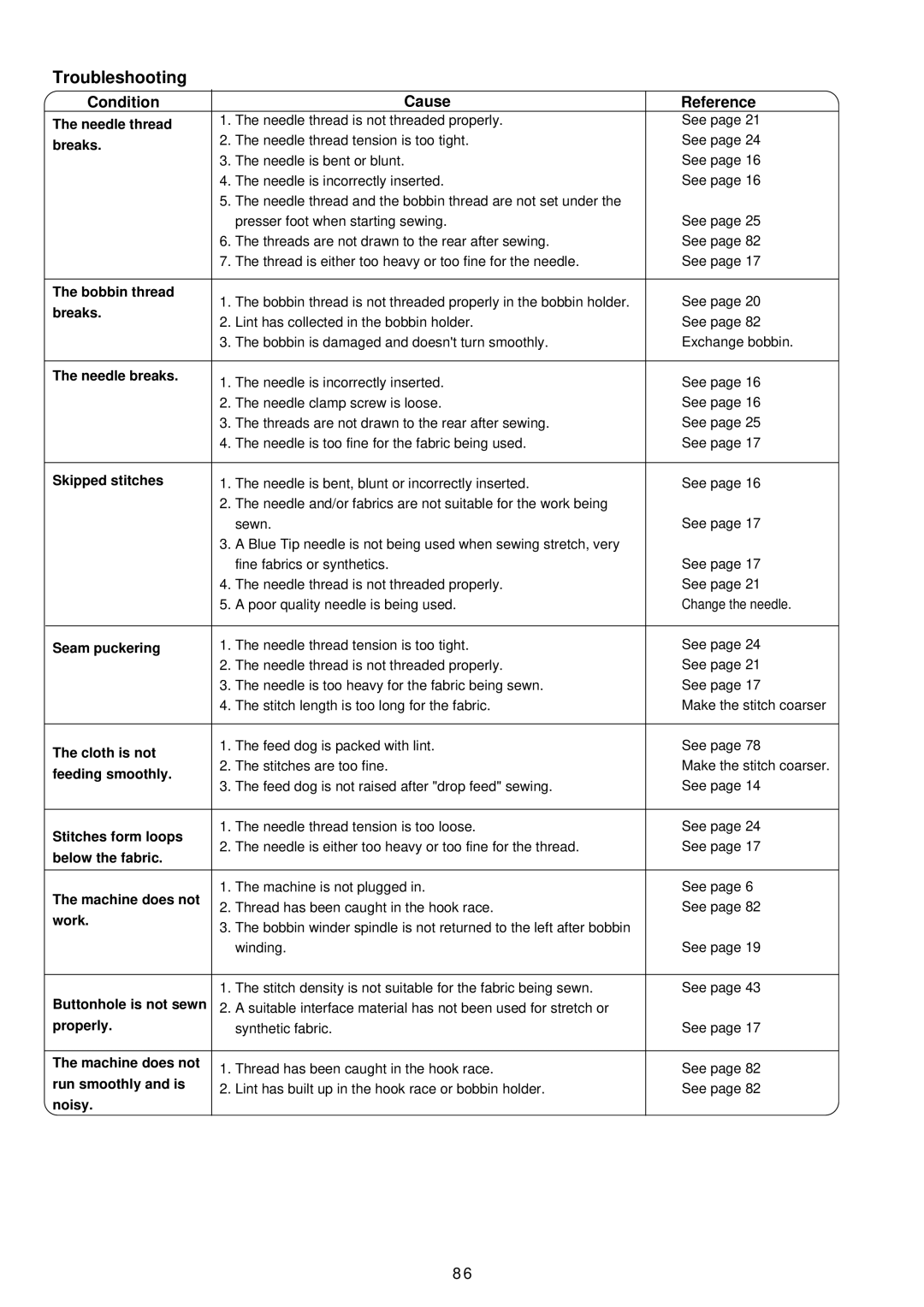
Troubleshooting
Condition |
| Cause | Reference | |
The needle thread | 1. The needle thread is not threaded properly. | See page 21 | ||
breaks. | 2. | The needle thread tension is too tight. | See page 24 | |
3. | The needle is bent or blunt. | See page 16 | ||
| ||||
| 4. | The needle is incorrectly inserted. | See page 16 | |
| 5. | The needle thread and the bobbin thread are not set under the |
| |
|
| presser foot when starting sewing. | See page 25 | |
| 6. | The threads are not drawn to the rear after sewing. | See page 82 | |
| 7. | The thread is either too heavy or too fine for the needle. | See page 17 | |
|
|
|
| |
The bobbin thread | 1. | The bobbin thread is not threaded properly in the bobbin holder. | See page 20 | |
breaks. | ||||
2. | Lint has collected in the bobbin holder. | See page 82 | ||
| ||||
| 3. | The bobbin is damaged and doesn't turn smoothly. | Exchange bobbin. | |
|
|
|
| |
The needle breaks. | 1. | The needle is incorrectly inserted. | See page 16 | |
| ||||
| 2. | The needle clamp screw is loose. | See page 16 | |
| 3. | The threads are not drawn to the rear after sewing. | See page 25 | |
| 4. | The needle is too fine for the fabric being used. | See page 17 | |
|
|
| ||
Skipped stitches | 1. The needle is bent, blunt or incorrectly inserted. | See page 16 | ||
| 2. | The needle and/or fabrics are not suitable for the work being |
| |
|
| sewn. | See page 17 | |
| 3. | A Blue Tip needle is not being used when sewing stretch, very |
| |
|
| fine fabrics or synthetics. | See page 17 | |
| 4. | The needle thread is not threaded properly. | See page 21 | |
| 5. | A poor quality needle is being used. | Change the needle. | |
|
|
| ||
Seam puckering | 1. The needle thread tension is too tight. | See page 24 | ||
| 2. | The needle thread is not threaded properly. | See page 21 | |
| 3. | The needle is too heavy for the fabric being sewn. | See page 17 | |
| 4. | The stitch length is too long for the fabric. | Make the stitch coarser | |
|
|
|
| |
The cloth is not | 1. | The feed dog is packed with lint. | See page 78 | |
2. | The stitches are too fine. | Make the stitch coarser. | ||
feeding smoothly. | ||||
3. | The feed dog is not raised after "drop feed" sewing. | See page 14 | ||
| ||||
|
|
|
| |
Stitches form loops | 1. | The needle thread tension is too loose. | See page 24 | |
2. | The needle is either too heavy or too fine for the thread. | See page 17 | ||
below the fabric. | ||||
|
|
| ||
|
|
| ||
The machine does not | 1. The machine is not plugged in. | See page 6 | ||
2. | Thread has been caught in the hook race. | See page 82 | ||
work. | ||||
3. | The bobbin winder spindle is not returned to the left after bobbin |
| ||
|
| |||
|
| winding. | See page 19 | |
|
|
|
| |
Buttonhole is not sewn | 1. | The stitch density is not suitable for the fabric being sewn. | See page 43 | |
2. A suitable interface material has not been used for stretch or |
| |||
properly. |
| synthetic fabric. | See page 17 | |
|
|
|
| |
The machine does not | 1. | Thread has been caught in the hook race. | See page 82 | |
run smoothly and is | ||||
2. | Lint has built up in the hook race or bobbin holder. | See page 82 | ||
noisy. | ||||
|
|
| ||
|
|
|
| |
8 6
